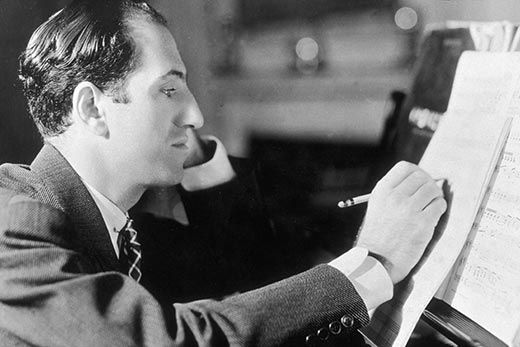I'm Barbara Klein. And I'm Steve Ember with People in America in VOA Special English. Today we tell about the life and music of one of America's greatest composers, George Gershwin. That was the opening of "Rhapsody in Blue," composed by George Gershwin. Gershwin lived only thirty-nine years. Yet, in that short time, he wrote hundreds of unforgettable popular songs. He wrote some concert works, such as "Rhapsody in Blue," that are still performed today. And he wrote what many consider to be the most beautiful American opera, "Porgy and Bess. "
George Gershwin was born in New York City in eighteen ninety-eight. His parents were Russian Jews who had immigrated to the United States. George and his two brothers and sister had a close, happy family life. George liked playing games on the streets of New York. He liked exploring the city. He did not like school or studying. While exploring the city, George heard jazz and blues music spilling out of public drinking places. However, he did not become seriously interested in music until he heard another boy playing the violin in a concert at his school. George began to take piano lessons. His teacher was a fine classical musician. He immediately recognized George's unusual ability. The teacher wrote about him to a friend: "I have a student who will make his mark in music, if anybody will. The boy is a genius, without doubt. "

George studied classical piano. But his strongest interest continued to be jazz and popular music. At the age of fifteen, he left school and went to work in the music business. The New York City street where most music publishers had their offices was called "Tin Pan Alley." The phonograph and radio had been invented in the late eighteen hundreds. But it would be many years before there were musical recordings or regular radio broadcasts. Tin Pan Alley publishers needed another way to sell new songs. So, they employed people to play the piano to do this. The piano players played the songs all day long to interested singers and other performers. George Gershwin was one of the youngest piano players in Tin Pan Alley. Soon, he was considered one of the finest there. He was already writing his own songs. He succeeded in getting one published when he was only eighteen years old. It had a long title: "When You Want 'Em, You Can't Get 'Em, When You've Got 'Em, You Don't Want 'Em."
George Gershwin was now a real composer. The rest of his life was an unbroken record of success. He wrote song after song. His ideas were so endless that he was not even troubled when he once lost some music he had been writing. "There is plenty more where that came from," he said. George Gershwin had his first big hit in nineteen nineteen, when he was twenty-one years old. It was a song called "Swanee." A popular entertainer, Al Jolson, sang the song. "Swanee" was made into one of the first musical recordings. George Gershwin was suddenly famous. Here is Al Jolson singing what became his trademark song, "Swanee." Music critics note that "Swanee" is not like most of George Gershwin's music. Later, he wrote true love songs. Some were light and funny. Some were full of intense feeling. Many of these songs were written for the popular musical theater. One of his most emotional love songs never became part of a musical play, however. It is called "The Man I Love." Here is a modern recording by Maureen McGovern.
George Gershwin's older brother, Ira, wrote the words to that song. As George became famous, Ira wrote the words to more and more of his songs. The two brothers were very different. Ira, the writer, was quiet and serious. George, the musician, was outgoing -- the life of any party. But George wrote better songs with Ira than with anyone else. It is impossible to imagine many of George's songs without Ira's perfectly chosen, often surprising words. One of many examples is the song "They Can't Take That Away From Me." The Gershwins wrote the song for dancer and actor Fred Astaire for the film "Shall We Dance." That was George and Ira Gershwin's first movie musical. Here is Fred Astaire, followed by a later version sung by Ella Fitzgerald.












